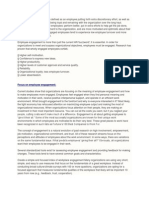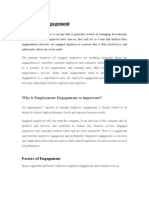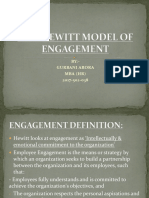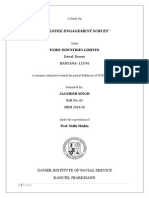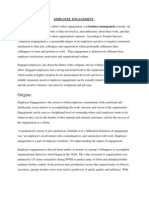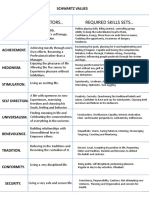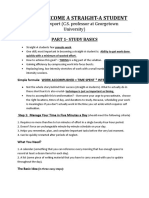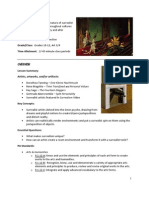Employee Engagement - Definition: A Study On Employee Engagement in Aparajitha Corporate Services (P) LTD 1
Employee Engagement - Definition: A Study On Employee Engagement in Aparajitha Corporate Services (P) LTD 1
Uploaded by
jayasrikCopyright:
Available Formats
Employee Engagement - Definition: A Study On Employee Engagement in Aparajitha Corporate Services (P) LTD 1
Employee Engagement - Definition: A Study On Employee Engagement in Aparajitha Corporate Services (P) LTD 1
Uploaded by
jayasrikOriginal Title
Copyright
Available Formats
Share this document
Did you find this document useful?
Is this content inappropriate?
Copyright:
Available Formats
Employee Engagement - Definition: A Study On Employee Engagement in Aparajitha Corporate Services (P) LTD 1
Employee Engagement - Definition: A Study On Employee Engagement in Aparajitha Corporate Services (P) LTD 1
Uploaded by
jayasrikCopyright:
Available Formats
INTRODUCTION
Employee engagement is one step ahead of employee satisfaction. Employee is not only satisfied with the management decisions, salary and things but also giving back to the organization in terms of commitment, dedication, and loyalty. Employee Engagement is the level of commitment an employee has towards the organization. The primary behaviors of engaged employees are: speaking positively about the organization to coworkers, potential employees and customers, having a strong desire to be a member of the organization, and exerting extra effort to contribute to the organizations success. A fully engaged employee is intellectually and emotionally bound with the organization, gives 100 percent, feels passionately about its goals and is committed to live by its values. This employee goes beyond the basic job responsibility to delight the customers and drive the business forward. Moreover, in times of diminishing loyalty, employee engagement is a powerful retention strategy. Research shows that engaged employees: perform better, put in extra efforts to help get the job done, show a strong level of commitment to the organization, and are more motivated and optimistic about their work goals. Employers with engaged employees tend to experience low employee turnover and more impressive business outcomes.
Employee Engagement Definition
Employee engagement definitions vary from a positive emotional connection to an employees work to engaged employees are inspired to go above and beyond the call of duty to help meet business goals
A Study on Employee Engagement in Aparajitha Corporate Services (p) Ltd
IES defines engagement as: a positive attitude held by the employee towards the organization and its values. An engaged employee is aware of business context, and works with colleagues to improve performance within the job for the benefit of the organisation. The organisation must work to develop and nurture engagement, which requires a two-way relationship between employer and employee. Engagement is the energy, passion, or fire in the belly employees have for their employer Stay Say : Desire to be a member of the organization : Speak positively about the organisation
Strive : Go beyond what is minimally required
Employee Engagement- Difference
The difference between employee satisfaction, employee effectiveness and employee engagement. Satisfaction, effectiveness, and engagement are all inter-related in an upward progression. Each item has different drivers, but they build on one another to increase performance in the workplace. Think about it, just because employees are satisfied with their job does not mean they are effective or engaged. It is possible for an employee to be completely satisfied with his or her job, and not be fully engaged. To further complicate matters, an employee can be both engaged and satisfied, yet not be effective. All three components work together to create an environment where employees are highly motivated and committed to giving their best performance.
A Study on Employee Engagement in Aparajitha Corporate Services (p) Ltd
ENGAGEMENT THE EVOLUTIONARY JOURNEY
Higher
Engagement
Business Performance Positive Correlation
How much people wantand actually do improve business results
With
Commitment
How much people want to improve business results
Satisfaction
How much people like it here
Lower
Employee Research over Time
Focus on employee engagement:
Current studies show that organizations are focusing on the meaning of employee engagement and how to make employees more engaged. Employees feel engaged when they find personal meaning and motivation in their work, receive positive interpersonal support, and operate in an efficient work environment. What brought engagement to the forefront and why is everyone interested in it? Most likely, the tight economy has refocused attention on maximizing employee output and making the most of organizational resources. When organizations focus attention on their people, they are making an investment in their most important resource. You can cut all the costs you want, but if you neglect your people, cutting costs wont make much of a difference. Engagement is all about getting employees to give it their all. Some of the most successful organizations are known for their unique work environments in which
A Study on Employee Engagement in Aparajitha Corporate Services (p) Ltd
employees are motivated to do their very best. These great places to work have been recognized in such lists as Fortunes 100 Best Companies to Work For. The concept of engagement is a natural evolution of past research on highinvolvement, empowerment, job motivation, organizational commitment, and trust. All of these research streams focus on the perceptions and attitudes of employees about the work environment. In some ways, there are variations on the same fundamental issue. What predicts employees giving their all? Obviously, all organizations want their employees to be engaged in their work. Several standardized tools exist for assessing employee engagement and providing feedback for making changes. These tools tend to have several common goals and characteristics: Create a simple and focused index of workplace engagement-Many organizations are using very short, simple, and easy to use measures that focus on the fundamentals of a great workplace. Instead of conducting broad culture/climate surveys with 100 or more questions, organizations are opting for a focused approach that measures fundamental qualities of the workplace that likely will be important 10 years from now (e.g., feedback, trust, cooperation). Allow for benchmarking-Most organizations want to know how they compare to other organizations. Using a standard measure of engagement allows organizations to see how they compare to other companies along a simple set of fundamental work qualities. Direct action-Engagement measures tend to be very actionable. This means that the organization can alter practices or policies to affect employees responses to every item in the measure. Show relationship to company performance-Without a link to company performance or other critical outcomes, measures of engagement have little value. The whole idea behind engagement is that it leads to enhanced performance. The link to performance outcomes is a necessary underlying assumption of all engagement measures.
A Study on Employee Engagement in Aparajitha Corporate Services (p) Ltd
Engagement Predicts Organizational Success
Many studies have shown that investments in people (i.e., HR-related practices) have a reliable impact on the performance of organizations. The Bureau of Labor conducted a comprehensive review of more than 100 studies and found that people practices have significant relationships to improvements in productivity, satisfaction, and financial performance. Research has shown that when engagement scores are high, employees are more satisfied, less likely to leave the organization, and more productive. Each organization is different and there are many factors that affect bottom-line outcomes; however, engagement scores can serve as meaningful predictors of long-term success. Some organizations use engagement scores as lead measures in their HR scorecards. When an organization can show the relationship between engagement scores and bottom-line outcomes, everyone pays attention to the engagement index. Establishing this critical link between people and performance helps HR professionals prove that people-related interventions are a worthwhile investment.
Elements of Engagement
Some researches conclude that personal impact, focused work, and interpersonal harmony comprise engagement. Each of these three components has sub-components that further define the meaning of engagement.
Personal Impact-Employees feel more engaged when they are able to make a unique contribution, experience empowerment, and have opportunities for personal growth. Past research (e.g., Conger and Kanugo, 1988; Thomas and Velthouse, 1990) concurs that issues such as the ability to impact the work environment and making meaningful choices in the workplace are critical components of employee empowerment. Development Dimensions Internationals (DDI) research on retaining talent (Bernthal and Wellins, 2000) found that the perception of meaningful work is one of the most influential factors determining employees willingness to stay with the organization.
A Study on Employee Engagement in Aparajitha Corporate Services (p) Ltd
Focused Work-Employees feel more engaged when they have clear direction, performance accountability, and an efficient work environment. Aside from the personal drive and motivation to make a contribution, employees need to understand where to focus their efforts. Without a clear strategy and direction from senior leadership, employees will waste their time on the activities that do not make a difference for the organizations success. Additionally, even when direction is in place, employees must receive feedback to ensure that they are on track and being held accountable for their progress. In particular, employees need to feel that low performance is not acceptable and that there are consequences for poor performance. Finally, employees want to work in an environment that is efficient in terms of its time, resources, and budget. Employees lose faith in the organization when they see excessive waste. For example, employees become frustrated when they are asked to operate without the necessary resources or waste time in unnecessary meetings.
Interpersonal Harmony-Employees feel more engaged when they work in a safe and cooperative environment. By safety, we mean that employee trust one another and quickly resolve conflicts when they arise. Employees want to be able to rely on each other and focus their attention on the tasks that really matter. Conflict wastes time and energy and needs to be dealt with quickly. Some researches also find that trust and interpersonal harmony is a fundamental underlying principle in the best organizations. Employees also need to cooperate to get the job done. Partnerships across departments and within the work group ensure that employees stay informed and get the support they need to do their jobs.
A Study on Employee Engagement in Aparajitha Corporate Services (p) Ltd
Making Use of Engagement
Measurement of employee engagement can have many applications in the organization. Earlier, it is mentioned that engagement could serve as a general index of HR effectiveness in an HR scorecard. Also, engagement measures serve as an easy way to benchmark the work climate against other organizations.
Other uses include:
Needs Analysis-The fundamental issues measured in engagement provide a quick index of what leaders and HR need to do to make things better. In addition, items in engagement surveys tend to be very actionable. This means that leaders or others in the organization can take action that will affect the score on a single item.
Evaluation-Many learning and performance interventions are designed to impact some aspect of engagement. When an engagement measure is used as a pre-implementation baseline, the impact of the intervention can be gauged by measuring post-implementation changes in engagement.
Climate Survey-Some organizations like to use engagement measures as simple indexes of the workplace culture. While more extensive surveys are valuable, sometimes its easier to focus attention on a few simple and proven factors.
Leader or Department Feedback-Depending on the demographic information collected when the engagement measure is implemented, one can create breakout reports by department or leader. This means departments and leaders can gain a better understanding of how engagement in their groups differs from the rest of the organization. This information can be used to create development plans or plans for larger-scale interventions.
A Study on Employee Engagement in Aparajitha Corporate Services (p) Ltd
Employee engagement is more than just the current HR 'buzzword'; it is essential. In order for organizations to meet and surpass organizational objectives, employees must be engaged. Research has proven that wholly engaged employees exhibit,
Higher self-motivation. Confidence to express new ideas. Higher productivity and Morale. Higher levels of customer approval and service quality. Reliability. Organizational loyalty; less employee turnover. Lower absenteeism. Increased passion for, commitment to and alignment with the organizations strategies and goals. Boosted business growth. Employees become effective brand ambassadors for company.
Diagnostic tool for employee engagement include the following
- training - development - career - performance appraisals - performance management - communication - equal opportunity - fair treatment - pay - benefits - health - safety
A Study on Employee Engagement in Aparajitha Corporate Services (p) Ltd 8
- cooperation - family orientation - friendliness - job satisfaction
There are three levels of Employee Engagement
1. Engaged employees 2. Not engaged employees 3. Actively disengaged employees Engaged employees work with passion and feel a profound connection to their company. They drive innovation and move the organization forward. Not Engaged employees are essentially checked out. Theyre sleepwalking through their workday, putting time but not energy or passion into their work. Actively disengaged employees arent just unhappy at work; theyre busy acting out their happiness. Every day, these workers undermine what their engaged coworkers accomplish.
KEY ORGANIZATION ENGAGEMENT OUTCOME METRICS -Employee Retention -Company Performance -Customer Satisfaction -Profitability
A Study on Employee Engagement in Aparajitha Corporate Services (p) Ltd
Conditions that prevent employee engagement seldom alleviate themselves. They should be assessed and addressed as soon as possible. Left to multiply, negative employee satisfaction issues can result in:
Higher employee turnover - Employees leave, taking their reservoir of Diminished performance - Competency of the workforce is reduced, at Lost training dollars - Time and money invested in training and
knowledge and experience to another workplace
least short term, until new employees are trained
development programs for departing workers is wasted Lower morale - Remaining employees can be overburdened with new duties, in addition the unresolved issues that already prevent their full engagement.
Exhibit: Engagement level of employees world wide
Country Mexico Brazil U.S. Belgium Canada Germany Ireland U.k. Spain Korea France Netherlands China Italy India Japan Global
www.towersperrin.com
% Engaged 40% 31% 21% 18% 17% 15% 15% 12% 11% 9% 9% 8% 7% 7% 2% 4% 14%
% Not Engaged 51% 62% 63% 67% 66% 70% 70% 65% 64% 71% 68% 73% 67% 64% 37% 57% 62%
% Disengage 9% 7% 16% 15% 17% 15% 15% 23% 25% 20% 23% 19% 25% 29% 56% 41% 24%
A Study on Employee Engagement in Aparajitha Corporate Services (p) Ltd
10
You might also like
- Strategic Design and Innovative Thinking in Business OperationsDocument463 pagesStrategic Design and Innovative Thinking in Business OperationsHieuhanh TruongNo ratings yet
- Employee Engagement CIPDDocument29 pagesEmployee Engagement CIPDejazsuleman50% (2)
- Airtel NewDocument64 pagesAirtel NewAbith Gowda100% (2)
- Focus On Employee EngagementDocument3 pagesFocus On Employee EngagementSneha BandarkarNo ratings yet
- Employee Engagement at DR Reddy's FinalDocument89 pagesEmployee Engagement at DR Reddy's Finalahmed100% (2)
- Introdution:: Key Implications and RecommendationsDocument13 pagesIntrodution:: Key Implications and RecommendationsJackulin JasNo ratings yet
- Introduction 2Document74 pagesIntroduction 2Ravi KumaranNo ratings yet
- 1Document16 pages1Aswathy VargheseNo ratings yet
- Copy Paste tata-WPS OfficeDocument31 pagesCopy Paste tata-WPS Officesomachoudhary093No ratings yet
- Employee EngagementDocument24 pagesEmployee Engagementarabsar100% (1)
- FF GaganDocument88 pagesFF GagannotbatmanofgothamNo ratings yet
- Employee EngagementDocument11 pagesEmployee EngagementManisha Singh100% (1)
- Human Resources - Ijhrmr - Employee Engagement For - KanimozhiDocument6 pagesHuman Resources - Ijhrmr - Employee Engagement For - KanimozhiTJPRC PublicationsNo ratings yet
- Employee EngagementDocument11 pagesEmployee EngagementReena Shyam100% (1)
- Final Project - ShayamDocument98 pagesFinal Project - ShayamShayam SundarNo ratings yet
- Chapter-1: 1.1-Meaning of Employee EngagementDocument44 pagesChapter-1: 1.1-Meaning of Employee EngagementVandu Little HeartsNo ratings yet
- Employee EngageDocument77 pagesEmployee EngagecomicpogoNo ratings yet
- Employee EngagementDocument55 pagesEmployee Engagementkrishna saiNo ratings yet
- Employee SatisfactionDocument106 pagesEmployee SatisfactionPatan Najeema100% (3)
- Aon Hewitt Model of EngagementDocument10 pagesAon Hewitt Model of Engagementgurbani100% (1)
- Employee Engagement RefinedDocument7 pagesEmployee Engagement RefinedKaranja SamuelNo ratings yet
- Conceptual FrameworkDocument12 pagesConceptual FrameworkKumarNo ratings yet
- Employee EngagementDocument25 pagesEmployee EngagementPratik Khimani100% (4)
- Emloyee EngagementDocument7 pagesEmloyee EngagementMuhammad SohaibNo ratings yet
- Fostering E Engagement in Ur OrgDocument6 pagesFostering E Engagement in Ur OrgAmidu1No ratings yet
- Literature Review: Effects of Employee Relation On OrganizationDocument5 pagesLiterature Review: Effects of Employee Relation On OrganizationHameeda ShoukatNo ratings yet
- Article On HR and Multi Variate AnalysisDocument10 pagesArticle On HR and Multi Variate AnalysisRaghuram SeshabhattarNo ratings yet
- Employee Engagement Vs Employee Satisfaction White PaperDocument11 pagesEmployee Engagement Vs Employee Satisfaction White PaperOsmania MbaNo ratings yet
- Review of LiteratureDocument47 pagesReview of LiteratureAnil BaroliaNo ratings yet
- HRM CAMPUS ExperienceDocument15 pagesHRM CAMPUS ExperiencemadhurikachintaNo ratings yet
- .... Employee Satisfaction Hetero DrugsDocument82 pages.... Employee Satisfaction Hetero Drugsmoula nawazNo ratings yet
- Highly Engaged EmployeesDocument12 pagesHighly Engaged EmployeesmaynannooNo ratings yet
- Employee EngagementDocument6 pagesEmployee EngagementMay Oo Khin NyeinNo ratings yet
- Employee EngagementDocument6 pagesEmployee EngagementsamchikkuNo ratings yet
- Human Resource Management: Final ProjectDocument17 pagesHuman Resource Management: Final ProjectCompanion Institute of CommerceNo ratings yet
- Synopsis - Employee EngagementDocument17 pagesSynopsis - Employee EngagementJagshish SinghNo ratings yet
- AON HewittDocument2 pagesAON HewittRutuja Kshirsagar HandaNo ratings yet
- A Study On Employee Engagement in Present Scenario: S.GousiaDocument6 pagesA Study On Employee Engagement in Present Scenario: S.GousiaIOSRJEN : hard copy, certificates, Call for Papers 2013, publishing of journalNo ratings yet
- Icic BankDocument29 pagesIcic Bankjassi7nishadNo ratings yet
- Employee EngagementDocument73 pagesEmployee EngagementVinayaka Mc100% (2)
- Chapter-1 1.1 Introduction and Research DesignDocument13 pagesChapter-1 1.1 Introduction and Research DesignSwathiNo ratings yet
- Employee EngagementDocument13 pagesEmployee EngagementManoj Ramachandran NairNo ratings yet
- Employee SatisfactionDocument107 pagesEmployee SatisfactionDhatriIndia100% (1)
- Talent Acquisition NotesDocument7 pagesTalent Acquisition NotesnandiniNo ratings yet
- CH 5 HRMDocument13 pagesCH 5 HRMagragamidegree collegeNo ratings yet
- 1.1 Introduction To TopicDocument11 pages1.1 Introduction To TopicNivedita SolankeNo ratings yet
- SHRMDocument12 pagesSHRMSweta Singh100% (2)
- Jo ProjectDocument79 pagesJo ProjectManoj KumarNo ratings yet
- SynopsisDocument16 pagesSynopsisInfo TechNo ratings yet
- Employee Engagement Is Not The Same As Employee SatisfactionDocument3 pagesEmployee Engagement Is Not The Same As Employee SatisfactionrashbasheerNo ratings yet
- Employee EngagementDocument8 pagesEmployee EngagementsaranyaramrajNo ratings yet
- Employee Engagement: The Psychology Behind Individual BehavioursDocument8 pagesEmployee Engagement: The Psychology Behind Individual BehavioursIlto SandovalNo ratings yet
- Job Satisfaction RRLDocument39 pagesJob Satisfaction RRLMarie Tiffany100% (1)
- 8 Employee Engagement in Indian Scenerio - A Case Study of Tata Tele Services Limited (TTSL)Document12 pages8 Employee Engagement in Indian Scenerio - A Case Study of Tata Tele Services Limited (TTSL)Sushant SinghNo ratings yet
- Compensation Systems, Job Performance, and How to Ask for a Pay RaiseFrom EverandCompensation Systems, Job Performance, and How to Ask for a Pay RaiseNo ratings yet
- Amazeing Organizational Teams: Navigating 7 Critical Attributes for Cohesion, Productivity and ResilienceFrom EverandAmazeing Organizational Teams: Navigating 7 Critical Attributes for Cohesion, Productivity and ResilienceNo ratings yet
- The Engagement Manifesto: A Systemic Approach to Organisational SuccessFrom EverandThe Engagement Manifesto: A Systemic Approach to Organisational SuccessNo ratings yet
- A Joosr Guide to... The Carrot Principle by Adrian Gostick and Chester Elton: How the Best Managers Use Recognition to Engage Their People, Retain Talent, and Accelerate PerformanceFrom EverandA Joosr Guide to... The Carrot Principle by Adrian Gostick and Chester Elton: How the Best Managers Use Recognition to Engage Their People, Retain Talent, and Accelerate PerformanceNo ratings yet
- The Power of Stay Interviews for Engagement and RetentionFrom EverandThe Power of Stay Interviews for Engagement and RetentionNo ratings yet
- The Impact of Diversity and Inclusion initiatives on Organizational performanceDocument8 pagesThe Impact of Diversity and Inclusion initiatives on Organizational performancelakshikavats22No ratings yet
- Lab Managment 2 2Document20 pagesLab Managment 2 2ShereenNo ratings yet
- (PDF Download) How To Be A Successful Student 20 Study Habits Based On The Science of Learning 1st Edition Mayer Fulll ChapterDocument53 pages(PDF Download) How To Be A Successful Student 20 Study Habits Based On The Science of Learning 1st Edition Mayer Fulll Chaptertomazkipfer100% (6)
- Time Management What Do University Students ThinkDocument14 pagesTime Management What Do University Students Thinknhidpbiochem.hcmiuNo ratings yet
- Question and Answer - 42Document31 pagesQuestion and Answer - 42acc-expertNo ratings yet
- Managing Staff Development For Learning and Teaching: Master of Arts in Nursing In-Service Education in NursingDocument7 pagesManaging Staff Development For Learning and Teaching: Master of Arts in Nursing In-Service Education in NursingHazel Joy Hokson-DiazNo ratings yet
- CFLM 2 Lesson 1 To 8Document118 pagesCFLM 2 Lesson 1 To 8Dave Chan100% (2)
- Hakomi SimplyfiedDocument24 pagesHakomi SimplyfiedJesús Palacios Serna100% (2)
- Values SchwartsDocument1 pageValues SchwartsPrakash16No ratings yet
- Chapter 10Document15 pagesChapter 10Jemaicah AmatiagaNo ratings yet
- Gamification Frameworks GamesDocument9 pagesGamification Frameworks Gamesbruno ferreira lopezNo ratings yet
- 2 Sem - Bcom - Marketing and Services ManagementDocument90 pages2 Sem - Bcom - Marketing and Services ManagementMunni ChukkaNo ratings yet
- Banas2011 PDFDocument31 pagesBanas2011 PDFBlack DevilNo ratings yet
- Goal Setting WorkshopDocument8 pagesGoal Setting WorkshopRod HyattNo ratings yet
- Chapter 15 Test BankDocument38 pagesChapter 15 Test Bankshanjidakterimi0% (2)
- The Conditional Cash TransferDocument11 pagesThe Conditional Cash TransferChristian Surio RamosNo ratings yet
- The Humanistic Theory in EducationDocument34 pagesThe Humanistic Theory in EducationJeddahlyn Atienza RamosNo ratings yet
- Ra Final Rough DraphDocument5 pagesRa Final Rough Draphapi-583017409No ratings yet
- Health EducationDocument13 pagesHealth EducationRegimae BartolomeNo ratings yet
- John Mills - Control - A History of Behavioral Psychology (1998, NYU Press) PDFDocument258 pagesJohn Mills - Control - A History of Behavioral Psychology (1998, NYU Press) PDFVeronica100% (4)
- Lydia e Hall Core Care and Cure Models SeminarDocument25 pagesLydia e Hall Core Care and Cure Models SeminarLeo KizhakkeveedanNo ratings yet
- Hbomod 4 - Iapapril2015Document31 pagesHbomod 4 - Iapapril2015Jose Raphael JaringaNo ratings yet
- What Do You Say When?Document14 pagesWhat Do You Say When?JC Dela CruzNo ratings yet
- Ihrm - Understanding Culture and Multiculturalism: Rohini M BudhirajaDocument26 pagesIhrm - Understanding Culture and Multiculturalism: Rohini M Budhirajanav sainiNo ratings yet
- How To Become A StraightDocument16 pagesHow To Become A StraightRajsukh Mohanty100% (2)
- Surreal Perspective Lesson PlanDocument9 pagesSurreal Perspective Lesson Planapi-220176001No ratings yet
- MSPS 11Document295 pagesMSPS 11mba departmentNo ratings yet
- What The Best Therapists Are Like As PeopleDocument6 pagesWhat The Best Therapists Are Like As PeopleIsmael RodriguezNo ratings yet



